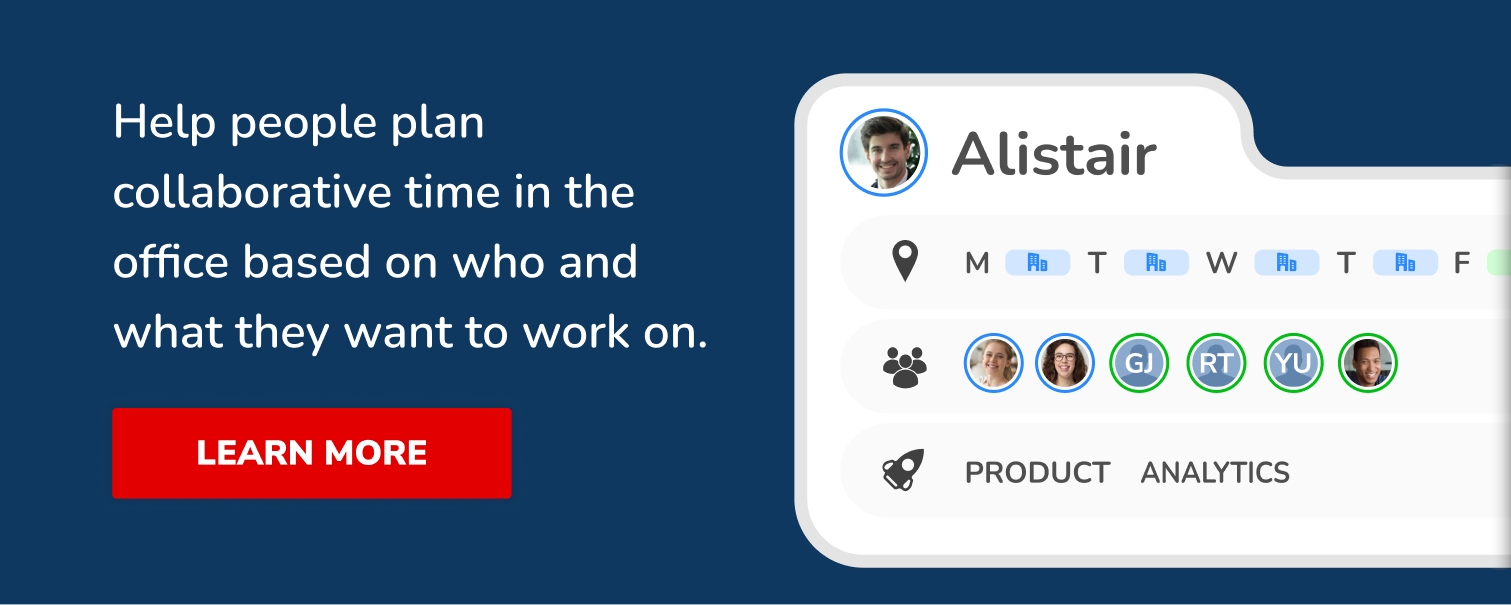Hybrid teams need to decide which days are best to work from the office. In this post, we look at the best ways for hybrid teams to coordinate their office time together to maximise impact and output.
Hybrid working is not just about staying home sometimes. Today's hybrid models allow people to choose when they work, how they work, and where they work. People have more flexibility today than ever before which can become a headache for managers trying to effectively organise hybrid teams. How can you manage these teams to ensure there is always some structure in the workplace?
Many people now get to structure their own day to suit their preferred work style. This flexibility opens the doors to the opportunity to go for a lunchtime run, spend time with the kids after school, or work from the local coffee shop for a change of scenery.
While the freedom of choice brings the benefits of health and well-being as well as increased job satisfaction, it has impacted people's ability to plan their work around their colleagues and key stakeholders in the office.
Employees may be working smarter, but companies are having to work harder to keep everybody on the same page. We've put together an easy system to make hybrid work as smooth as possible for people at all levels of every organisation.

How Are Teams Adapting To Hybrid Work?
Working from home has taught us that teams can be effective wherever they are, as long as there is clear communication with definitive boundaries and easy access to support when it's needed.
It’s clear that people are keen for hybrid work to stay as evidenced by data produced by Gallup in 2022, demonstrating the most popular hybrid work schedules of days spent in the office vs at home per week.
51% of employees are keen to spend between two and three days a week at the office. This statistic is sharply at odds with existing hybrid work schedules requiring employees to be on-site either one day per week or four.
How Hybrid Teams Are Adapting
One of the most interesting effects of the workforce transitioning to hybrid work is how teams are using the office. The office is no longer seen as necessary to the working day, and as a result, its purpose has shifted to specific uses i.e. collaboration and relationship building.
Most teams are adapting to hybrid working in the office in one of these three ways:
Teams Are Using The Office For Collaboration
Function plays a big role in team locations. Some people work quietly on their own projects to meet a common goal, while others need to bounce ideas around to get the best results.
Teams are coordinating when they come into the office so that key people are in the office at the same time for maximum productivity. Once the collaboration needs are filled, they can then work from anywhere to complete the work in their own space.
Teams Are Planning Their Work Tasks According To Their Location
Some tasks are easier to do from the office. Teams who work to a fixed location schedule are deciding their work content around when they're going to be in the office.
People are working on collaborative or interaction-heavy tasks from the office, and saving their independent more independent tasks for home. We're also seeing that teams are planning more sociable work for the office, like training.
Teams Are Using Office Days For Featured Experiences
The office has become a fantastic place for team-building activities! Teams are getting together in the office to kickstart new projects with a high-energy boost, which is leading to greater productivity and increased motivation.
Managers and team leaders are using office days to improve training and development. Bringing the team into the office is also ideal for encouraging active networking, nurturing company culture, or offering people a well-deserved treat for good work done.

Biggest Challenge Of Hybrid Work: Coordinating Schedules
Hybrid work has many benefits for both employers and employees but many organisations are still experiencing issues surrounding coordinating schedules to be in the office at the same time.
The classic Excel spreadsheet just doesn't work anymore. Flexibility brings chaos to the roster, so the more people come and go at their leisure, the more confusing it becomes to manage.
Scheduling hybrid work is a significant problem. The extra productivity that hybrid brings gets eroded by the extra work needed to coordinate location with others.
If the issue isn’t tackled then siloes can form within teams leading to miscommunication and misunderstandings arising. As best there might be missed meetings, at worst, it could mean deadlines being missed and reduced profits.
The bigger your business gets, the bigger the problem gets. People plan to come in on a certain day and hope the right person will also be there. Even if people coordinate when to be in, plans change and people aren't notified.
This issue is compounded by the research which shows that the most engaged employees are not tied down by fixed hybrid schedules. The happiest and most productive employees are free to choose their office days and fit their life around work.
How can companies get the best of both worlds with the autonomy and flexibility of hybrid work combined with seamless scheduling that coordinates people in the office at the same time?

How Companies Used To Coordinate Hybrid Team Schedules
Teams across the world have struggled to find the perfect system for coordinating who works from where on any given day. Most businesses have tried one of these popular methods:
1. Spreadsheets
The oldest method is a simple spreadsheet, with teams keeping a schedule in a shared spreadsheet. They can add when they plan to work from the office to the spreadsheet so that others know what to expect.
This method is effective, but it relies heavily on people remembering to update their movements, which can mean that they simply forget to mention they're not coming into the office today.
Human error can cause a lot of issues and if this method was truly functional, then there wouldn’t be a need for other strategies.
2. Shared Calendars
Like spreadsheets, shared calendars give colleagues the ability to see what others intend to do. Everyone puts where they plan to work into a calendar, and anyone can look up someone's plans.
Shared calendars rely on people actively checking who will be where which takes time. Human nature means that people forget to check, and our natural desire for impulsivity means people often change their plans at the last minute. This disrupts the team's overall day as a result of simple co-ordination error.
An advantage of spreadsheets and shared calendars is that they are cost-effective, but if the lack of coordination leads to a decrease in productivity, the small amount of money saved may actually be harming overall company profits.
3. Desk Booking Tools
Employees can book a space ahead of coming into the office, but people can't forward plan if others don't book their desk until the day. Desk booking systems are limited by what other people do, which is difficult to plan around.
People also find that planning to sit next to a particular person optimises their schedule for one individual but limits their interactions with the full team. This can be sub-optimal over time.
When people come into the office, they will likely want to maximise their collaboration on that day and organise different meetings as well as take advantage of any informal meetings that could arise.
4. Hope For The Best
Many people do nothing at all to plan where they work. They simply turn up and see who else is around that day. This lets people have full flexibility, but makes active collaboration a daily lottery ticket.
All four of the above methods are fraught with issues, chiefly relating to relying on individuals having to use their memories and organisational skills to coordinate with others. If employees are having to waste time in their workday trying to coordinate with their team members for a meeting, this is a major resource leak and needs to be rectified immediately.

What do hybrid teams need for effective coordination?
It’s easy to point out the problems in trying to coordinate hybrid teams, but before finding a solution, we need to first examine what it is that hybrid team members require in order to coordinate effectively.
Individuals working together in well-oiled hybrid teams all share these common points:
- They understand which tasks they must achieve on any given day, and where those particular tasks will be easiest to do, be it at home or in the office.
- Each individual knows who they need to collaborate with on a daily or project basis.
- They get to know themselves and their job demands, so they can actively structure their work around their own optimal performance patterns.
- They establish clear goals for workplace training, and identify who in the office can help them achieve their goals.
- Each member decides how much they need to socialise with others in the office to stay happy, so they can determine which days are best for nights out or active networking.
Best Way To Coordinate Hybrid Team Schedules
Advanced Hybrid Work Scheduling Software, such as DuoMe's flexible work scheduling tool, uses sophisticated technology to overlay people's individual needs into a simple hybrid schedule that works for all.
Unprecedented workplace flexibility has created a world where each of the popular scheduling systems has shown limitations that hinder productivity. People are running around each other, and they're relying on memory or basic courtesy to make big decisions that affect their performance.
However, when you use technology to solve your greatest hybrid work challenge, you're giving your teams time and stability to focus on their tasks. This builds strong relationships, develops trust throughout your organisation, and improves productivity.
Hybrid work lets employees work according to their needs rather than their allocated location, but location is an essential part of every employee's individual success story.
Get in touch to learn more, or book a free demo to see how DuoMe can simplify your day today!
About Author
Graham Joyce is co-founder of DuoMe, a flexible working advocate and a frequent panellist/commentator on the issues of flexibility or hybrid working.







